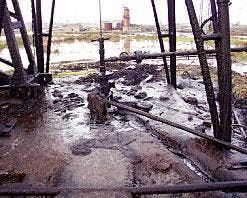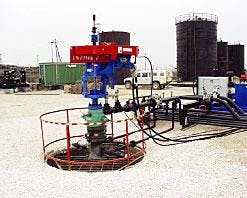Canadian outfit reworks giant Albania heavy oil field
A unit of Bankers Petroleum Ltd., Calgary, is redeveloping giant Patos-Marinza heavy oil field in central Albania under an existing license between state Albpetrol ShA and the National Petroleum Agency of Albania.
Reworking and equipping wells with progressive cavity pumps brought production to 2,300 b/d from 57 wells in early December compared with about 600 b/d when Bankers Petroleum signed the contract with state Albpetrol in mid-2004. Bankers Petroleum unit Saxon International Energy Ltd. holds 100% working interest in all of the field’s 2,500 original wells.
Albpetrol separately produces 3,000 b/d from 600 wells in the field.
Patos-Marinza, discovered in 1928 and placed on production in 1939, is producing 10-11° gravity oil from an estimated 1.95 billion bbl of original oil in place in the Driza, Marinza, and Gorani formations at 300 ft to 5,900 ft deep. Historical recovery rates have been only 6% of OOIP, Bankers Petroleum said.
Bankers Petroleum plans to have submitted a final development plan to Albpetrol by the end of 2005. That plan is to involve recompleting a total of 600-900 wells to western standards under primary heavy oil recovery techniques.
Bankers Petroleum exported 22,000 bbl of Patos-Marinza crude from the Adriatic Sea port of Vlore, Albania, to an undisclosed Italian refinery. It plans a second shipment soon.
Patos-Marinza is one of continental Europe’s largest onshore oil fields in terms of OOIP. The 44,000-acre field peaked at 13,000 b/d in the early 1960s. Consulting engineers estimated P50 reserves at Sept. 30, 2004, at 35 million bbl proved and 98.2 million bbl proved plus probable.
The game plan is generally to boost production at each well to 40-50 b/d from 5 b/d, said Richard Wadsworth, president of Bankers Petroleum.
On taking over each site in Albania’s Patos-Marinza field (top), Bankers Petroleum shuts down the well, removes the derrick, and revamps surface equipment (bottom). It collects soils and a small amount of produced sand at a central site for possible later application in road building as is common in western Canada.
Albpetrol hands over clusters of wells at a time to Bankers Petroleum, which uses local workover rigs for its operations (see story, p. 47). Wells are on spacing as close as 4 acres. Most production is from the Driza, but some wells are completed in more than one formation.
The Cold Heavy Oil Production process involves drawing down a well’s fluid level to induce sand production and create channels or “wormholes” in the reservoir. This releases gas that foams the oil, reducing its viscosity and aiding its movement to the wellbore where it is efficiently lifted by progressive cavity pumps.
All work is primary recovery for now. Horizontal drilling, 3D seismic, steam assisted gravity drainage, and other production optimization techniques may be applicable once the development plan is approved, Wadsworth added. ✦

